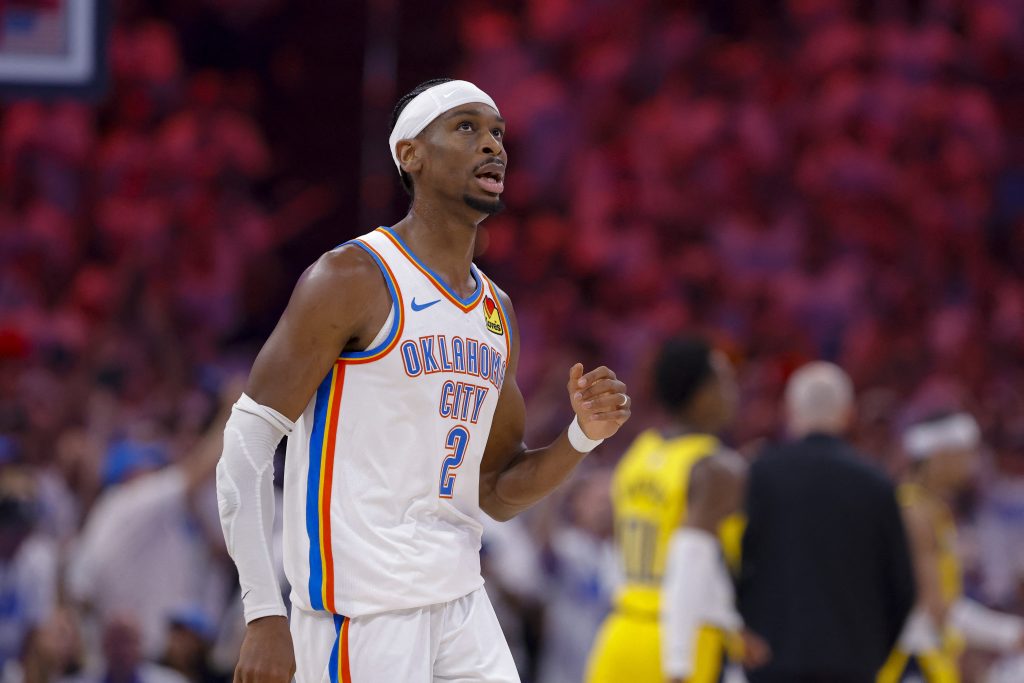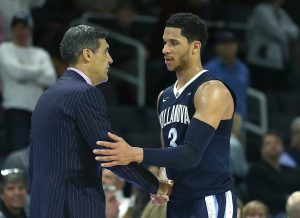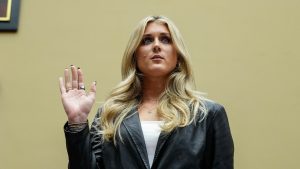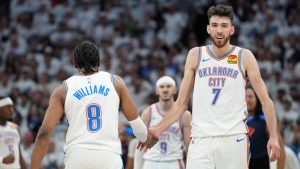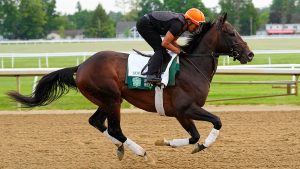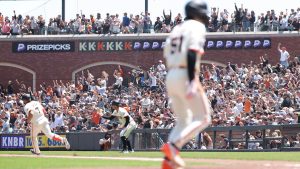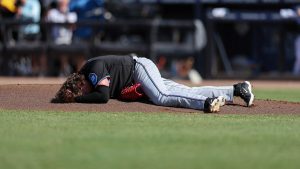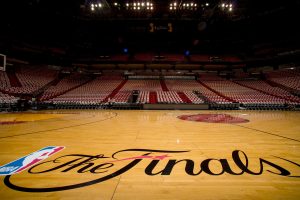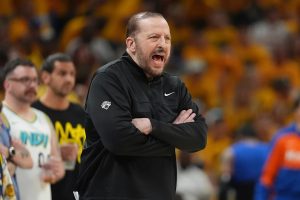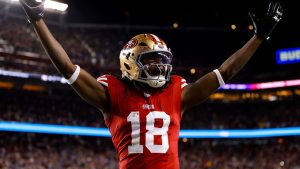OKLAHOMA CITY — Rick Carlisle wants to make one thing abundantly clear: The Pacers are not looking for Shai Gilgeous-Alexander to go off.
“We are not looking to get Shai going,” he said Saturday on the eve of Game 2 of the 2025 NBA Finals. “That doesn’t make any sense.”
That stands to reason! If the other team’s best player has the ball a ton, and is doing a lot with it, it’s reasonable to assume that it would be a bad thing for your defense.
Here’s the thing, though:
• In the second round of the Eastern Conference playoffs against the Pacers, Donovan Mitchell wound up averaging 34.2 points on 25 field-goal attempts per game, finishing a mammoth 41% of the Cavaliers’ offensive possessions with a shot attempt, foul drawn or turnover — a usage rate more than 10% higher than it had been against Miami the previous round. (Injuries to Darius Garland, Evan Mobley and De’Andre Hunter played a role there.)
In a possibly related story: Only one other Cleveland player (Mobley) averaged more than 15 points per game in the series, and a Cavaliers team whose league-leading offense assaulted the record books all season long scored just 109.6 points per 100 possessions in Mitchell’s minutes in the conference semifinals — same as the 25th-ranked Toronto Raptors managed during the regular season. The Pacers drummed Cleveland out of the playoffs in five games.
• In the Eastern Conference finals against the Pacers, Jalen Brunson went off, averaging 30.7 points on 20.8 field-goal attempts per game and finishing 34.4% of the Knicks’ offensive possessions with a shot attempt, foul drawn or turnover — a usage rate nearly 5% higher than it had been against Boston the previous round.
In a possibly related story: Only one other New York player (Karl-Anthony Towns) averaged more than 18 points per game in the series, and a Knicks team that ranked fifth in the NBA in offensive efficiency during the regular season scored just 114.3 points-per-100 in Brunson’s minutes in the conference finals — a league-average scoring rate. The Pacers drummed New York out of the playoffs in six.
• And hey, sure, given your druthers, you’d certainly prefer that the NBA’s reigning Most Valuable Player not score 30-plus points on you — as Gilgeous-Alexander did on Thursday, pouring in 38 to lead the Thunder in the Pacers’ shocking Game 1 win.
If he’s going to, though, you’d probably like those points to come as inefficiently as possible. Say, on 30 shot attempts — tied for the third-highest total of his career. And probably while soaking up a ton of possessions. Like, for example, a 37.1% usage rate — the third-highest mark of his playoff career. And maybe even while dominating the ball to a greater degree than usual. For instance, a total time of possession of 8.8 minutes — up more than two minutes from the regular season and more than one minute from the first three rounds.
In a possibly related story: Only one other Oklahoma City player (Jalen Williams) scored more than 15 points in Game 1, and a Thunder offense that scored a scorching 122.4 points per 100 possessions with Gilgeous-Alexander on the floor during the regular season and 116.2 points-per-100 with SGA at the controls through the first three rounds of the postseason, scored just 104.7 points-per-100 in the MVP’s minutes in Game 1 — a sub-Wizardian rate of offensive inefficiency that would’ve ranked dead last in the NBA during the regular season.
Oh, and the Pacers won the game.
“Coming into the series, their wins and losses in the playoffs, he was [scoring] in the 30s in wins and low-to-mid-20s in losses,” Carlisle said. “… We want to make it hard.”
Totally. You know what’s really hard, though? Needing to generate virtually everything by and for yourself, possession after possession, against what’s been a top-10 defense for the last six months, led by one of the NBA’s best point-of-attack defenders in the gaining-respect-by-the-day Andrew Nembhard, while the opponent sells out to cut off your teammates and burn your lifeboats.
How the Pacers played SGA in Game 1
OK, so maybe “give the best guy on the team as many shots as he can handle” isn’t exactly Indiana’s double-secret defensive game plan.
As blueprints for success go, though, “force that player to make a ton of tough 2-point shots, keep anyone else from getting off, and when possible, funnel touches and shots to less-threatening options” — like, for example, by having rangy power forwards Pascal Siakam and Obi Toppin cross-match against Thunder guard Luguentz Dort, sag way off him to play more aggressive help defense and then live with him taking dare-you 3s when the ball finds him … well, that wouldn’t be the worst one ever constructed against a team that relies so heavily on its elite top option.
The Pacers threw a ton at Gilgeous-Alexander in Game 1. The MVP saw a heavy dose of Canadian national teammate Nembhard as his primary defender, with Siakam, Aaron Nesmith and Bennedict Mathurin also pulling shifts. Indiana was also aggressive in showing help in the gaps on Gilgeous-Alexander’s isolations and drives, and “next-ing” his pick-and-rolls — having the defender who’s nearest to the play switch over onto SGA as he drives, with his initial defender switching back onto SGA’s now-uncovered teammate — to try to corral him in the two-man game.
“He’s the MVP of our league, so you’re not going to shut a guy like that down,” Pacers guard T.J. McConnell said Saturday. “He’s a special talent. It’s just about making things as difficult as possible and trying to tire him out and wear him down. Credit to everyone that guarded him. They played a part in trying to do that. Obviously, he had a phenomenal game, but it’s a collective effort.”
That effort extends to the defensive end of the floor: The Pacers went 7 of 12 in Game 1 on plays where Gilgeous-Alexander was the closest defender, according to NBA Advanced Stats. As they did to Brunson last round, Indiana at times looked to target Gilgeous-Alexander — putting him into action, leveraging size mismatches on switches, attacking him in isolation — to ensure he wouldn’t get the benefit of a breather when he didn’t have the ball:
Then they went after SGA.
Got him switched on-ball — created an iso 3, a drive that drew rotation and an o-board (1 point), and a Siakam crash vs SGA for a put-back 2.
Relentless. pic.twitter.com/6JvnC6kdea— Michael Jagacki (@Mike_Jagacki) June 7, 2025
My favorite moment from that huge Nembhard iso 3 vs. SGA.
How Haliburton wanted Nembhard to go iso there — he spaced away, even signally to Siakam to space. He believes in his teammates more than most – it’s infectious pic.twitter.com/rrKtYq8iYF— Michael Jagacki (@Mike_Jagacki) June 7, 2025
“I think that’s what we’re trying to do: just make him work on both ends,” McConnell said. “I mean, he’s a great player. And you know, when great players play a lot of minutes, it can kind of get into their legs. Obviously, I’m not sure we saw a lot of that — he had 38 points. But it’s a process thing.”
Indiana will continue trusting that process, betting the deposits it puts in early will pay off with compound interest late. The Game 1 effort already paid some dividends, though, by influencing Gilgeous-Alexander to put the onus largely on himself. He passed out of just two of his 27 drives to the basket — emblematic of an outing that saw him call his own number more frequently than usual.
“I always try to be aggressive and I never, like, predetermine it,” Gilgeous-Alexander said Saturday. “I always just let the game tell me what to do. So I guess last game, I felt more often than not I had a shot or a play that I could attack on more than in the past, and that’s just the way it went.”
Gilgeous-Alexander averaged 41 passes per game during the regular season and 46 per game through the first three rounds of the playoffs. In Game 1, though? Just 38.
SGA wasn’t alone in playing less frequently off the pass, though: After averaging 270.7 passes per game in the regular season, and 256.6 during the first three rounds, Oklahoma City threw a shockingly low 207 passes in Game 1, leading to a season-low 13 assists.
“The same thing will happen in Game 2,” Gilgeous-Alexander said. “I will read the defense, and I will play off my feeling and my instincts, and if it’s calling for me to shoot or if it’s calling me to pass, that’s what I will decide to do.”
SGA will need help in Game 2
The key for the Thunder? If the game’s calling for Gilgeous-Alexander to pass — if, after film study, he recognizes that the crowd that Indiana’s showing him means some of his teammates are wide open — then they’ve got to knock ’em down at a much better clip than they did in Game 1.
Non-SGA Thunderers shot just 25 of 68 (36.8%) from the field — including a 5-of-19 mark off Shai’s passes — and 8 of 24 (33.3%) from 3-point land on Thursday. Strip out Dort’s 5-for-9 outing from beyond the arc, and the rest of Oklahoma City’s rotation went just 2 of 15 from deep — the kind of output that’s not exactly going to dissuade the Pacers from making Gilgeous-Alexander’s teammates prove they can knock down enough shots to make them pay for their defensive approach.
That puts the spotlight squarely on Williams, who needed 19 shots to score 17 points in Game 1, and on Chet Holmgren, who spoke Saturday about needing to improve his finishing after going 2 of 8 in the paint in Game 1 against the length and physicality of Turner on the interior.
“I think we had a good offensive process,” Williams said after Game 1. “We got some good shots towards the end. … I repped a lot of the shots that I shot tonight — over and over and over again, consistently, throughout my career, this year, the playoffs. All you can do is shoot them and not get scared to shoot them.”
Maintaining that mentality isn’t easy, especially when you know the opponent is betting that, if they throw everything they’ve got at stopping your teammate, you won’t be able to make them pay for it. But Williams said Saturday that knowing he’s Oklahoma City’s failsafe Plan B isn’t anything new for him and doesn’t come with additional pressure to score every time the ball swings his way.
Sometimes, though, the circumstances will demand Williams and Holmgren finish those possessions with a bucket — pulling a contested 3, finishing over Turner or Siakam at the rim, or just playing through contact to get to the foul line. Heady stuff for 23- and 24-year-olds.
“[Holmgren] and Dub, specifically, obviously, they have carved out huge roles on our team,” Thunder head coach Mark Daigneault said. “They are a huge reason why we’re here. They are in an uncommon position for third-year players … and now that they are here, they have to continue to do what they have done all the way through the playoffs, which is go out there, fully compete, learn the lessons and apply it forward.”
Williams, for his part, sounds ready to shake off Game 1 and do just that.
“Pressure is a privilege,” Williams said. “I enjoy being counted on.”
The Thunder are counting on him, Holmgren and everyone else to bounce back in a big way. The Pacers are counting on it, too.
“Look, everybody’s pattern after a loss is to come more aggressively,” Carlisle said. “So [Gilgeous-Alexander’s] going to be more aggressive. Williams is going to be more aggressive. Chet is going to be more aggressive. Their whole team is going to be even more aggressive defensively. The challenge for us is to be able to match that.”
If the Pacers can’t, they still walk out of Oklahoma City with a split. If they can, though — if they’re able to replicate what worked in Game 1 and improve on what didn’t — they could find themselves precisely where they’ve been in every series they’ve played in this postseason: up 2-0, in complete control, and in position to do something that very few people outside their locker room ever thought could be possible.
“We don’t want Shai getting 38 points if we can avoid it,” Carlisle said. “We don’t want him living on the free-throw line. We don’t want him getting easy 3s — we don’t want him making that 3 at the end of the third quarter. That was a tough shot, but he banged that in.
“We have to make it hard on him.”
OKLAHOMA CITY — Rick Carlisle wants to make one thing abundantly clear: The Pacers are not looking for Shai Gilgeous-Alexander to go off.
“We are not looking to get Shai going,” he said Saturday on the eve of Game 2 of the 2025 NBA Finals. “That doesn’t make any sense.”
Advertisement
Advertisement
Advertisement
That stands to reason! If the other team’s best player has the ball a ton, and is doing a lot with it, it’s reasonable to assume that it would be a bad thing for your defense.
Here’s the thing, though:
• In the second round of the Eastern Conference playoffs against the Pacers, Donovan Mitchell wound up averaging 34.2 points on 25 field goal attempts per game, finishing a mammoth 41% of the Cavaliers’ offensive possessions with a shot attempt, foul drawn or turnover — a usage rate more than 10% higher than it had been against Miami the previous round. (Injuries to Darius Garland, Evan Mobley and De’Andre Hunter played a role there.)
In a possibly related story: Only one other Cleveland player (Mobley) averaged more than 15 points per game in the series, and a Cavaliers team whose league-leading offense assaulted the record books all season long scored just 109.6 points per 100 possessions in Mitchell’s minutes in the conference semifinals — same as the 25th-ranked Toronto Raptors managed during the regular season. The Pacers drummed Cleveland out of the playoffs in five games.
• In the Eastern Conference finals against the Pacers, Jalen Brunson went off, averaging 30.7 points on 20.8 field goal attempts per game, finishing 34.4% of the Knicks’ offensive possessions with a shot attempt, foul drawn or turnover — a usage rate nearly 5% higher than it had been against Boston the previous round.
Advertisement
Advertisement
Advertisement
In a possibly related story: Only one other New York player (Karl-Anthony Towns) averaged more than 18 points per game in the series, and a Knicks team that ranked fifth in the NBA in offensive efficiency during the regular season scored just 114.3 points-per-100 in Brunson’s minutes in the conference finals — a league-average scoring rate. The Pacers drummed New York out of the playoffs in six.
• And hey, sure, given your druthers, you’d certainly prefer that the NBA’s reigning Most Valuable Player not score 30-plus points on you — as Gilgeous-Alexander did on Thursday, pouring in 38 to lead the Thunder in Game 1.
If he’s going to, though, you’d probably like those points to come as inefficiently as possible. Say, on 30 shot attempts — tied for the third-highest total of his career. And probably while soaking up a ton of possessions. Like, for example, a 37.1% usage rate — the third-highest mark of his playoff career. And maybe even while dominating the ball to a greater degree than usual. For instance, a total time of possession of 8.8 minutes — up more than two minutes from the regular season, and more than one minute from the first three rounds.
In a possibly related story: Only one other Oklahoma City player (Jalen Williams) scored more than 15 points in Game 1, and a Thunder offense that scored a scorching 122.4 points per 100 possessions with Gilgeous-Alexander on the floor during the regular season, and 116.2 points-per-100 with SGA at the controls through the first three rounds of the postseason, scored just 104.7 points-per-100 in the MVP’s minutes in Game 1 — a sub-Wizardian rate of offensive inefficiency that would’ve ranked dead last in the NBA during the regular season.
Advertisement
Advertisement
Advertisement
Oh, and the Pacers won the game.
“Coming into the series, their wins and losses in the playoffs, he was [scoring] in the 30s in wins and low-to-mid-20s in losses,” Carlisle said. “… We want to make it hard.”
Totally. You know what’s really hard, though? Needing to generate virtually everything by and for yourself, possession after possession, against what’s been a top-10 defense for the last six months, led by one of the NBA’s best point-of-attack defenders in the gaining-respect-by-the-day Andrew Nembhard, while the opponent sells out to cut off your teammates and burn your lifeboats.
OK, so maybe “give the best guy on the team as many shots as he can handle” isn’t exactly Indiana’s double-secret defensive game plan.
Advertisement
Advertisement
Advertisement
As blueprints for success go, though, “force that player to make a ton of tough 2-point shots, keep anyone else from getting off, and when possible, funnel touches and shots to less-threatening options” — like, for example, by having rangy power forwards Pascal Siakam and Obi Toppin cross-match against Thunder guard Luguentz Dort, sag way off of him to play more aggressive help defense, and then live with him taking dare-you 3s when the ball finds him … well, that wouldn’t be the worst one ever constructed against a team that relies so heavily on its elite top option.
The Pacers threw a ton at Gilgeous-Alexander in Game 1. The MVP saw a heavy dose of Canadian national teammate Nembhard as his primary defender, with Siakam, Aaron Nesmith and Bennedict Mathurin also pulling shifts. Indiana was also aggressive in showing help in the gaps on Gilgeous-Alexander’s isolations and drives, and “next-ing” his pick-and-rolls — having the defender who’s nearest to the play switch over onto SGA as he drives, with his initial defender switching back onto SGA’s now-uncovered teammate — to try to corral him in the two-man game.
“He’s the MVP of our league, so you’re not going to shut a guy like that down,” Pacers guard T.J. McConnell said Saturday. “He’s a special talent. It’s just about making things as difficult as possible and trying to tire him out and wear him down. Credit to everyone that guarded him. They played a part in trying to do that. Obviously, he had a phenomenal game, but it’s a collective effort.”
Advertisement
Advertisement
Advertisement
That effort extends to the defensive end of the floor: The Pacers went 7-for-12 in Game 1 on plays where Gilgeous-Alexander was the closest defender, according to NBA Advanced Stats. As they did to Brunson last round, Indiana at times looked to target Gilgeous-Alexander — putting him into action, leveraging size mismatches on switches, attacking him in isolation — to ensure that he wouldn’t get the benefit of a breather when he didn’t have the ball:
“I think that’s what we’re trying to do: just make him work on both ends,” McConnell said. “I mean, he’s a great player. And you know, when great players play a lot of minutes, it can kind of get into their legs. Obviously, I’m not sure we saw a lot of that — he had 38 points. But it’s a process thing.”
Advertisement
Advertisement
Advertisement
Indiana will continue trusting that process, betting that the deposits they put in early will pay off with compound interest late. The Game 1 effort already paid some dividends, though, by influencing Gilgeous-Alexander to put the onus largely on himself. He passed out of just two of his 27 drives to the basket — emblematic of an outing that saw him call his own number more frequently than usual.
“I always try to be aggressive and I never, like, predetermine it,” Gilgeous-Alexander said Saturday. “I always just let the game tell me what to do. So I guess last game, I felt more often than not I had a shot or a play that I could attack on more than in the past, and that’s just the way it went.”
Gilgeous-Alexander averaged 41 passes per game during the regular season and 46 per game through the first three rounds of the playoffs. In Game 1, though? Just 38.
SGA wasn’t alone in playing less frequently off the pass, though: After averaging 270.7 passes per game in the regular season, and 256.6 during the first three rounds, Oklahoma City threw a shockingly low 207 passes in Game 1, leading to a season-low 13 assists.
Advertisement
Advertisement
Advertisement
“The same thing will happen in Game 2,” Gilgeous-Alexander said. “I will read the defense, and I will play off my feeling and my instincts, and if it’s calling for me to shoot or if it’s calling me to pass, that’s what I will decide to do.”
The key for the Thunder? If the game’s calling for Gilgeous-Alexander to pass — if, after film study, he recognizes that the crowd that Indiana’s showing him means some of his teammates are wide open — then they’ve got to knock ‘em down at a much better clip than they did in Game 1.
Non-SGA Thunderers shot just 25-for-68 (36.8%) from the field — including a 5-for-19 mark off of Shai’s passes — and 8-for-24 (33.3%) from 3-point land on Thursday. Strip out Dort’s 5-for-9 outing from beyond the arc, and the rest of Oklahoma City’s rotation went just 2-for-15 from deep — the kind of output that’s not exactly going to dissuade the Pacers from making Gilgeous-Alexander’s teammates prove they can knock down enough shots to make them pay for their defensive approach.
That puts the spotlight squarely on Williams, who needed 19 shots to score 17 points in Game 1, and on Chet Holmgren, who spoke Saturday about needing to improve his finishing after going 2-for-8 in the paint in Game 1 against the length and physicality of Turner on the interior.
Advertisement
Advertisement
Advertisement
“I think we had a good offensive process,” Williams said after Game 1. “We got some good shots towards the end … I repped a lot of the shots that I shot tonight — over and over and over again, consistently, throughout my career, this year, the playoffs. All you can do is shoot them and not get scared to shoot them.”
Maintaining that mentality isn’t easy, especially when you know the opponent is betting that, if they throw everything they’ve got at stopping your teammate, you won’t be able to make them pay for it. But Williams said Saturday that knowing he’s Oklahoma City’s failsafe Plan B isn’t anything new for him, and doesn’t come with additional pressure to score every time the ball swings his way.
Sometimes, though, the circumstances will demand Williams and Holmgren finish those possessions with a bucket — pulling a contested 3, finishing over Turner or Siakam at the rim, or just playing through contact to get to the foul line. Heady stuff for a 23- and 24-year-old.
“[Holmgren] and Dub, specifically, obviously, they have carved out huge roles on our team,” Thunder head coach Mark Daigneault said. “They are a huge reason why we’re here. They are in an uncommon position for third-year players … and now that they are here, they have to continue to do what they have done all the way through the playoffs, which is go out there, fully compete, learn the lessons, and apply it forward.”
Advertisement
Advertisement
Advertisement
Williams, for his part, sounds ready to shake off Game 1 and do just that.
“Pressure is a privilege,” Williams said. “I enjoy being counted on.”
The Thunder are counting on him, Holmgren and everyone else to bounce back in a big way. The Pacers are counting on it, too.
“Look, everybody’s pattern after a loss is to come more aggressively,” Carlisle said. “So [Gilgeous-Alexander’s] going to be more aggressive. Williams is going to be more aggressive. Chet is going to be more aggressive. Their whole team is going to be even more aggressive defensively. The challenge for us is to be able to match that.”
Advertisement
Advertisement
Advertisement
If the Pacers can’t, they still walk out of Oklahoma City with a split. If they can, though — if they’re able to replicate what worked in Game 1 and improve on what didn’t — they could find themselves precisely where they’ve been in every series they’ve played in this postseason: up 2-0, in complete control, and in position to do something that very few people outside their locker room ever thought could be possible.
“We don’t want Shai getting 38 points if we can avoid it,” Carlisle said. “We don’t want him living on the free-throw line. We don’t want him getting easy 3s — we don’t want him making that 3 at the end of the third quarter. That was a tough shot, but he banged that in.
“We have to make it hard on him.”

